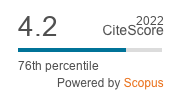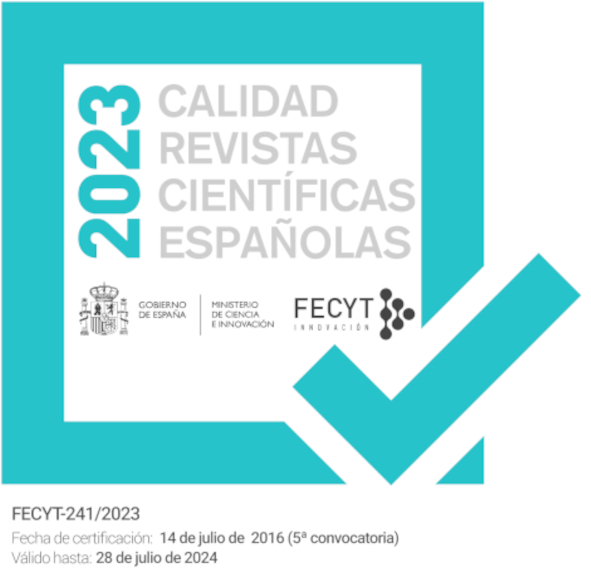Flash-flooding of Ephemeral Streams in the Context of Climate Change
DOI:
https://doi.org/10.18172/cig.4838Keywords:
intermittent rivers, environmental change, Mediterranean, inundation, riskAbstract
Ephemeral streams, which are more extended than expected, entail a significant flood risk. Historically they have been underestimated due to their intermittent flow and the lack of knowledge on their hydro-geomorphology. Currently, European legislation recognizes their associated risk and supports research into them, adapting the scale and methodology to their characteristics. Based on the compilation of various works carried out in four Valencian catchments (Eastern Spain), this paper approaches the key questions of rainfall-runoff conversion and flood generation in ephemeral streams, taking into account their hydro-geomorphological specificity. Moreover, the consequences which derive from current environmental changes are addressed in the wider scale of Júcar River Water Authority.
The study is based on 5-minute data, registered by the SAIH-Júcar network (Authomatic Hydrological Information System). The investigation has been conducted in two phases. Firstly, key issues determining flash-flood generation at basin scale have been addressed, based on the study of 138 floods, registered between 1989 and 2018, in four Valencian ephemeral streams (Barranc del Carraixet, Rambla de Poyo, Riu Vernissa and Rambla de Gallinera). Secondly, concerning a broader scale (Júcar River Water Authority), the evolution of 698 rain episodes (1989-2007) has been analysed. Finally, the consequences that environmental changes (climatic, anthropogenic and morphogenetic) might mean for flash-flood generation have been discussed.
The results show how environmental changes point towards an increase in risk to the detriment of resource. Rain episodes tend to increase in intensity and decrease accumulated precipitation. As a consequence, hydrological connectivity will become more dependent on rain intensity, thus reducing runoff thresholds and basin response times. Anthropic changes enhance this behaviour, reducing infiltration and increasing surface runoff and erosion, while accelerating the hydrological cycle. An increase in process-form disequilibrium in Mediterranean catchments can be expected due to the increase in morphogenetic phases (because of the intensification of events) and a decrease in the efficiency of low-magnitude recovery episodes.
Consequently, the behaviour of ephemeral-streams under current climate change conditions points firstly to an increase in intense flash-flood events, which will be difficult to manage with the current flood control measures, and secondly an increase in the general aridity conditions of catchments.
Downloads
References
Alves, A., Gersonius, B., Kapelan, Z., Vojinovic, Z., Sanchez, A. 2019. Assessing the Co-Benefits of green-blue-grey infrastructure for sustainable urban flood risk management. Journal of Environmental Management 239, 244-254, https://doi.org/10.1016/j.jenvman.2019.03.036.
Barredo, J.I., Engelen, G. 2010. Land Use scenario modelling for flood risk mitigation. Sustainability 2 (5), 1327-1344. https://doi.org/10.3390/su2051327
Beven, K. 2002. Runoff Generation in semi-arid areas. In: L.J. Bull, M.J. Kirkby (Eds.), Dryland Rivers: Hydrology and Geomorphology of Semi-Arid Channels. John Wiley and Sons, 57-105, Chichester, England.
Borga, M., Gaume, E., Creutin, J.D., Marchi, L., 2008. Surveying flash floods: gauging the ungauged extremes. Hydrol. Process. 22 (18), 3883-3885 https://doi.org/10.1002/hyp.7111.
Borga, M., Stoffel, M., Marchi, L., Marra, F., Jakob, M. 2014. Hydrogeomorphic response to extreme rainfall in headwater systems: flash floods and debris flows. Journal of Hydrology 518, 194-205. https://doi.org/10.1016/j.jhydrol.2014.05.022.
Bracken, L.J., Croke, J. 2007. The concept of hydrological connectivity and its contribution to understanding runoff-dominated geomorphic system. Hydrological Processes 21, 1749-1763. https://doi.org/10.1002/hyp.6313.
Bracken, L.J., Cox, N. J., Shannon, J. 2008. The relationship between rainfall inputs and flood generation in south-east Spain. Hydrological Processes 22, 683-696. https://doi.org/10.1002/hyp.6641.
Bracken, L.J., Wainwright, J., Ali, G. A., Tetzlaff, D., Smith, M.W., Reaney, S.M., Rou, A.G. 2013. Concepts of hydrological connectivity: Research approaches, pathways and future agendas. Earth-Science Reviews 119, 17-34. https://doi.org/10.1016/j.earscirev.2013.02.001.
Brakenridge, G.R. 1988. River flood regimen and floodplain stratigraphy. Floods Geomorphology. John Wiley & Sons, pp. 139-155. New York.
Bull, W.B., 1997. Discontinuous ephemeral streams. Geomorphology 19, 227-276. https://doi.org/10.1016/S0169-555X(97)00016-0.
Bull, L.J., Kirkby, M.J. 2002. Dryland river characteristics and concepts. In: L.J. Bull, M.J. Kirkby (Eds.). Dryland Rivers: Hydrology and Geomorphology of Semi-Arid Channels. John Wiley & Sons: Chichester, England.
Bull, L.J., Kirkby, M. J., Shannon, J., Hooke, J.M. 1999. The impact of rainstorms on floods in ephemeral channel in southeast Spain. Catena 38, 191-209. https://doi.org/10.1016/S0341-8162(99)00071-5.
Butzer, K.W. 2005. Environmental history in the Mediterranean world: cross-disciplinary investigation of cause-and-effect for degradation and soil erosion. Journal of Archaeological Science 32, 1773-1800. https://doi.org/10.1016/j.jas.2005.06.001.
Calsamiglia, A., García-Comendador, J., Fortesa, J., López-Tarazón, J.A., Crema, S., Cavalli, M., Calvo-Cases, A., Strany, J. 2018. Effects of agricultural drainage systems on sediment connectivity in a small Mediterranean lowland catchment. Geomorphology 318, 162-171. https://doi.org/10.1016/j.geomorph.2018.06.011.
Camarasa-Belmonte, A.M. 2016. Flash floods in Mediterranean ephemeral streams in Valencia Region (Spain). Journal of Hydrology 541(Part A), 99-115. https://doi.org/10.1016/j.jhydrol.2016.03.019
Camarasa-Belmonte, A.M. 2020. Cambio global y sostenibilidad. En: J. Farinós (Coor.) Desafios y oportunidades de un mundo en transición. Una interpretación desde la Geografía, PUV, 29-40.
Camarasa-Belmonte, A.M., López-García, M.J. 2006. Criterios de selección y caracterización de episodios de lluvia. Aplicación a la Confederación Hidrográfica del Júcar (1989-2003). Clima, Sociedad y Medio Ambiente, Publicaciones AEC, Serie A, 5, 323-336.
Camarasa-Belmonte, A.M., Soriano, J. 2014. Empirical study of extreme rainfall intensity in a semi-arid environment at different time scale. Journal of Arid Environments 100-101, 63-71. https://doi.org/10.1016/j.jaridenv.2013.10.008.
Camarasa-Belmonte, A.M., Caballero López, M.P., Iranzo García, E., 2018. Cambios de uso del suelo, producción de escorrentía y pérdida de suelo. Sinergias y compensaciones en una rambla mediterránea (Barranc del Carraixet, 1956-2011). Boletín de la Asociación de Geógrafos Españoles 78, 127-153. https://doi.org/10.21138/bage.2714.
Camarasa-Belmonte, A.M., Rubio, M., Salas, J. 2020. Rainfall events and climate change in Mediterranean environments: an alarming shift from resource to risk in Eastern Spain, Natural Hazards 103, 423-445. https://doi.org/10.1007/s11069-020-03994-x.
Cammeraat, E. 2004. Scale dependent thresholds in hydrological and erosion response of a semi-arid catchment in southeast Spain. Agriculture, Ecosystems and Environment 104, 317-332. https://doi.org/10.1016/j.agee.2004.01.032.
Cantón, Y., Solé-Benet, J., De Vente, J., Boix-Fayos, C., Calvo-Cases, A., Asensio, C., Puigdefábregas, J. 2011. A review of runoff generation and soil erosion across scales in semiarid south-eastern Spain. Journal of Arid Environments 75 (12), 1254-1261. https://doi.org/10.1016/j.jaridenv.2011.03.004
Conesa, C. 2005. Les 'ramblas' du Sud-est Espagnol: Systèmes hydromorphologiques en milieu méditerranéen. Zeitschrift für Geomorphologie 49, 205-224.
Costa, A.C., Foerster, S., Araújo, J.C., Bronstert, A. 2013. Analysis of channel transmission losses in a dryland river reach in north-eastern Brazil using streamflow series, groundwater level series and multi-temporal satellite data. Hydrological Processes 27, 1046-1060. https://doi.org/10.1002/hyp.9243.
Dunkerley, D.L. 2012. Effects of rainfall intensity fluctuations on infiltration and runoff: rainfall simulation on drylands soils, Fowlers Gap, Australia. Hydrological Processes 26, 2211-2224. https://doi.org/10.1002/hyp.8317.
Durán, Z.V.H., Rodríguez, P.C.R., Cuadros, T.S., Francia, M.J.R. 2014. Impacto de la erosión y escorrentía en laderas de agroecosistemas de montaña mediterránea. Ecosistemas 23(1), 66-72.
Estrela, M.J., Piró, J.J., Gómez, I. 2016. Clima y cambio climático en la Comunidad Valenciana. El Territorio Valenciano. Transformaciones ambientales y antrópicas 25-28.
European Environment Agency. 2019. River floods, climate change adaptation. Water and Marine Environments. https://www.eea.europa.eu/data-and-maps/indicators/river-floods-3/assessment. Accessed 31Jul 2020.
Feng, S., Fu, Q. 2013. Expansion of global drylands under a warming climate. Atmos. Chem. Phys. 13, 10081-10094. https://doi.org/10.5194/acp-13-10081-2013.
Gómez, R., Hurtado, I., Suárez, M.L., Vidal-Abarca, M.R. 2005. Ramblas in south-east Spain: threatened and valuable ecosystems. Aquat. Conserv. 15, 387-402. https://doi.org/10.1002/aqc.680.
González-Herrero, S., Bech, J. 2017. Extreme point rainfall temporal scaling: a long term (1805-2014) regional and seasonal analysis in Spain. International Journal of Climatology 37(15), 5068-5079. https://doi.org/10.1002/joc.5144.
Graff, W.L. 1988. Fluvial processes in dryland river, Springer, 345 pag., Berlin.
López-Bermúdez, F., Conesa-García, C., Alonso-Sarriá, F. 2002. Floods: magnitude and frequency in ephemeral streams of the Spanish Mediterranean Region. In: L. J. Bull, M. J. Kirkby (Eds.). Dryland Rivers: Hydrology and Geomorphology of Semi-Arid Channels. John Wiley and Sons, 329-350 pag., Chichester, England.
Marcos-García, P., Pulido-Velázquez, M. 2017. Cambio climático y planificación hidrológica: ¿es adecuado asumir un porcentaje único de reducción de aportaciones para la demarcación? Ingeniería del Agua 21(1), 35-52. https://doi.org/10.4995/ia.2017.6361.
MINECO (Ministerio para la Transición Ecológica). 2018. Inundaciones y Cambio Climático, Madrid. https://www.miteco.gob.es/es/agua/temas/gestion-de-los-riesgos-de-inundacion/libro-cambio-climatico-inundaciones-web-06092019_tcm30-499367.pdf (accessed 31 July 2020).
Miró, J.J., Estrela, M.J., Olcina, J. 2015. Statistical Downscaling and attribution of air temperature change patterns in the Valencia Region (1948-2011). Atmospheric Research 156, 189-212. https://doi.org/10.1016/j.atmosres.2015.01.003.
Morrell, J., Pérez-Cueva, A. 2000. Volúmenes hídricos de las precipitaciones intensas en la Confederación Hidrográfica del Júcar. Cuadernos de Geografía 67/68, 261-275.
Olcina, J. 2017. Incremento de episodios de inundación por lluvias de intensidad horaria en el sector central del litoral mediterráneo español: análisis de tendencias en Alicante. SÉMATA, Ciencias Socias e Humanidades 29, 143-163. http://hdl.handle.net/10045/73413.
Ollero, A. 2015. Buenas Prácticas en Restauración Fluvial (10 ejemplos). Informe técnico. https://doi.org/10.13140/RG.2.2.21171.84002.
Petrakis, M., Giannakopoulos, C., Lemesios, G. 2012. Report on observed changes and responses to climate change worldwide and in Cyprus. CYPADAPT- development of a national strategy for adaptation to climate change adverse impacts in Cyprus. LIFE10 ENV/CY/000723. DELIVERABLE 1.1. National Observatory of Athens, Athens, Greece. Available at: http://cypadapt.uest.gr/wp-content/uploads/DELIVERABLE1.1.pdf.
Romera, R., Gaertner, M.A, Sánchez, E., Domínguez, M., González-Alemán, J.J., Miglietta, M.M. 2017. Climate change projections of medicanes with a large multi-model ensemble of regional climate models. Global and Planetary Change 151, 134-143. https://doi.org/10.1016/j.gloplacha.2016.10.008.
Segura-Beltran, F., Sanchis-Ibor, C. 2013. Assessment of channel changes in a Mediterranean ephemeral stream since the early twentieth century. The Rambla de Cervera, eastern Spain. Geomorphology 201, 199-214, https://doi.org/10.1016/j.geomorph.2013.06.021.
Shannon, J., Richardson, R., Thornes, J. 2002. Modelling event-based fluxes in ephemeral streams. In: L. J. Bull, M. J. Kirkby (Eds.). Dryland Rivers: Hydrology and Geomorpohology of Semi-Arid Channels, 129-172 pag., John Wiley and Sons, Chichester, England.
Skoulikidis, N.T. Sabater, S., Datry, T., Morais, M.M., Buffagni, A., Dörflinger, G., Zoogaris, S., Sánchez-Montoya, M.M., Bonada, N., Kalogianni, E., Rosado, J., Vardakas, L., De Girolamo, A.M., Tockner, K. 2017. Non-perennial Mediterranean rivers in Europe: status, pressures, and challenges for research and management. Science of the Total Environment 577, 1-8. https://doi.org/10.1016/j.scitotenv.2016.10.147.
Snelder, T.H., Datry, T., Lamouroux, N., Larned, S.T., Sauquet, E., Pella, H., Catalogne, C. 2013. Regionalization of patterns of flow intermittence from gauging station records. Hydrol. Earth Syst. Sci. 17, 2685–2699.
Tarolli, P., Borga, M., Morin, E., Delrieu, G. 2012. Analysis of flash flood regimes in the North-Western and South-Eastern Mediterranean regions, Nat. Hazards Earth Syst. Sci. 12, 1255-1265. https://doi.org/10.5194/nhess-12-1255-2012.
Témez, J.R. 1978. Cálculo hidrometeorológico de caudales máximos en pequeñas cuencas naturales. Dir. General de Carreteras, Serv. de Publ., Madrid.
Valdes‐Abellan, J., Pardo, M.A., Tenza‐Abril, A.J. 2017. Observed precipitation trend changes in the western Mediterranean region. International Journal of Climatology 37, 1285-1296. https://doi.org/10.1002/joc.4984.
Wainwright, J., Turnbull, L., Ibrahim, T.G., Lexartza-Artza, I., Thornton, S.F., Brazier, R. 2011. Linking environmental regimes, space and time: interpretations of structural and functional connectivity. Geomorphology 126, 387-404. https://doi.org/10.1016/j.geomorph.2010.07.027.
Wolman, M.G., Gerson, R. 1978. Relative scales of time and effectiveness of climate in watershed geomorphology. Earth Surface Processes 3, 189-208. https://doi.org/10.1002/esp.3290030207.
Xoplaki, E., Trigo, R.M., García-Herrera, R., Barriopedro, D., D’Andrea, F., Fischer, E.M., Gimeno, L., Gouveia, C., Hernández, E., Kuglitsch, F.G., Mariotti, A., Nieto, R., Pinto, J.G., Pozo-Vázquez, D., Saaroni, H., Toreti, A., Trigo, I.F., Vicente-Serrano, S.M., Yiou, P., Ziv, B. 2012. 6-Large-Scale Atmospheric Circulation Driving Extreme Climate Events in the Mediterranean and its Related Impacts. The Climate of the Mediterranean Region. Elsevier, 347-417. https://doi.org/10.1016/B978-0-12-416042-2.00006-9.
Yair, A., Kossovosky, A. 2002. Climate and surface properties: hydrological response of small arid and semi-arid watersheds. Geomorphology 42, 43-57. https://doi.org/10.1016/S0169-555X(01)00072-1.
Yair, A., Raz-Yassif, N. 2004. Hydrological processes in a small arid catchment: scale effects of rainfall and slope length. Geomorphology 61, 155-169. https://doi.org/10.1016/j.geomorph.2003.12.003.
Zoccatelli, D., Borga1, M., Viglione, A., Chirico, G.B., Blöschl, G. 2011. Spatial moments of catchment rainfall: rainfall spatial organisation, basin morphology, and flood response. Hydrol. Earth Syst. Sci. 15, 3767-3783. https://doi.org/10.5194/hess-15-3767-2011.
Zoccatelli, D., Marra, F., Armon, M., Rinat, Y., Smith, J.A., Morin, E. 2019. Contrasting rainfall-runoff characteristics of floods in desert and Mediterranean basins. Hydrol. Earth Syst. Sci. 23, 2665-2678; https://doi.org/10.5194/hess-23-2665-2019.
Downloads
Published
How to Cite
Issue
Section
License
The authors retain copyright of articles and authorize Cuadernos de Investigación Geográfica / Geographical Research Letters the first publication. They are free to share and redistribute the article without obtaining permission from the publisher as long as they give appropriate credit to the editor and the journal.
Self-archiving is allowed too. In fact, it is recommendable to deposit a PDF version of the paper in academic and/or institutional repositories.
It is recommended to include the DOI number.
This journal is licensed under a Creative Commons Attribution 4.0 International License











